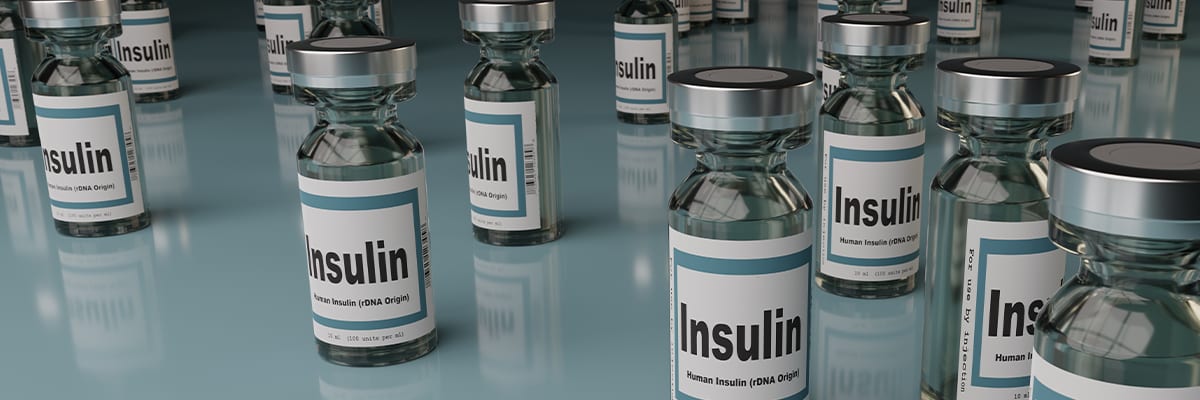The Insulin Supply Chain: A Guide for Transport & Storage
Learn How Maintaining the Proper Storage and Transportation Temperature of Insulin Ensures its Efficacy

Insulin plays an important role in blood sugar regulation. While insulin is naturally produced by the pancreas in many people, insulin products are used by people with diabetes to manage their condition.
The insulin supply chain is critical because insulin is a temperature-sensitive product that must be stored and transported within a specific temperature range to maintain its efficacy. It involves multiple supply chain partners and requires the use of specialized technologies and processes to maintain the efficacy of insulin during transport and storage.
An Overview of Insulin & the Insulin Supply Chain
Insulin is a hormone that is naturally produced by the pancreas, and it plays a critical role in regulating blood sugar levels in the body. It helps the body to convert glucose into energy and store it for later use. People with diabetes, a disease that affects the body's ability to produce or use insulin effectively, require regular doses of insulin to manage their blood sugar levels.
According to the Centers for Disease Control and Prevention (CDC), approximately 34.2 million people in the United States have diabetes, which is around 10.5% of the total population. This is a significant number, and it underscores the importance of having a reliable and efficient insulin supply chain to ensure that people with diabetes have access to the insulin they need to manage their condition.
The insulin supply chain refers to the complex process of transporting insulin from the point of manufacture to the end-user. It involves multiple stakeholders, including manufacturers, distributors, healthcare providers, and patients. The supply chain starts with the production of insulin by pharmaceutical companies and ends with the administration of insulin by healthcare providers or patients.
The insulin supply chain is critical because insulin is a temperature-sensitive product that must be stored and transported within a specific temperature range to maintain its efficacy. Insulin is typically stored at temperatures between 2°C and 8°C (36-46°F), and it must be transported in insulated containers that can maintain these temperatures during transit. Any deviations from the recommended temperature range can cause insulin to lose its efficacy, which can be dangerous for people with diabetes.
To ensure the safe and efficient transport and storage of insulin, the insulin supply chain relies on a variety of technologies and processes, including temperature monitoring devices, data loggers, and validated packaging materials. These tools enable stakeholders to monitor the temperature and condition of insulin throughout the supply chain and take corrective action if necessary.
Types of Insulin
There are several types of insulin available today, and each type has a different onset, peak, and duration of action. The types of insulin include rapid-acting, short-acting, intermediate-acting, and long-acting insulin.
Rapid-acting insulin
Rapid-acting insulin starts to work within 15 minutes of injection and peaks in about an hour. This type of insulin is typically taken before meals to help control blood sugar levels after eating. Examples of rapid-acting insulin include Novolog, Humalog, and Apidra.
Short-acting insulin
This type of insulin is also known as regular insulin. It, takes effect within 30 minutes of injection and peaks in 2-3 hours. It is typically taken before meals to help control blood sugar levels. Examples of short-acting insulin include Humulin R and Novolin R.
Intermediate-acting insulin
Intermediate-acting insulin takes effect within 2-4 hours of injection and peaks in 4-12 hours. It is typically taken twice a day to help control blood sugar levels. Examples of intermediate-acting insulin include NPH (Neutral Protamine Hagedorn) insulin such as Humulin N and Novolin N.
Long-acting insulin
This form of insulin takes effect within 1-2 hours of injection and lasts for 24 hours or more. It is typically taken once a day to help control blood sugar levels. Examples of long-acting insulin include Lantus, Levemir, and Toujeo.
There are also two types of insulin based on their source: analogue and human insulin.
Analogue insulin
Analogue insulin is a synthetic form of insulin that is designed to work more quickly and last longer than human insulin. It includes rapid-acting and long-acting insulin. Examples of analogue insulin include Novolog, Humalog, and Lantus.
Human insulin
This type of insulin is extracted from the pancreas of cows or pigs and is the oldest form of insulin available. It is available in short-acting and intermediate-acting forms. Examples of human insulin include Humulin R and Novolin N.It's important to note that all types of insulin, regardless of their source, must be stored properly to maintain their efficacy. Insulin should be stored at refrigerated temperatures between 2°C and 8°C, and may be kept at room temperature (between 15°C and 30°C) for up to 28 days after being opened. Insulin should never be frozen, and it should not be exposed to heat or direct sunlight.
How is Insulin Transported?
The transportation of insulin is a critical component of the insulin supply chain, and it involves several steps to ensure that insulin remains within the recommended temperature range and is delivered to its intended destination.
The Production of Insulin
The first step in insulin transportation is the manufacture of insulin by pharmaceutical companies. Once the insulin has been produced, it is packaged and labeled for distribution.
Insulin in Distribution Centers
The insulin is then transported from the manufacturer to distribution centers, where it is stored in refrigerated conditions until it is ready to be shipped to healthcare providers or patients. During this stage, temperature monitoring devices are used to ensure that the insulin remains within the recommended temperature range.
Shipping Insulin to the Final Destination
Once the insulin is ready to be shipped, it is transported to its final destination using specialized insulated containers that maintain the required temperature during transit. These containers can range in size from small coolers for individual doses of insulin to large shipping containers for bulk shipments.
Monitoring Insulin for Temperature Changes
During transportation, the insulin is continuously monitored using temperature data loggers, which record the temperature at regular intervals. If the temperature deviates from the recommended range, corrective action is taken to ensure that the insulin remains within the required temperature range, or it is designated as not fit for use and destroyed.
Storing Insulin
When the insulin reaches its final destination, it is typically stored in refrigerated conditions until it is ready to be used. Healthcare providers or patients can then administer the insulin as needed to manage blood sugar levels.
Challenges for Shipping Insulin
Shipping insulin is not without its challenges, and drug companies face several obstacles when transporting insulin to its final destination, especially at handover points at ports and airports where the shipment can be exposed to weather conditions.
Supply Chain Disruptions
One of the biggest challenges of shipping insulin is supply chain disruptions. Any interruption in the supply chain can result in delays or even a complete halt in insulin delivery, which can have serious consequences for people with diabetes who depend on insulin to manage their blood sugar levels. Supply chain disruptions can be caused by various factors, including natural disasters, political instability, or transportation issues.
Temperature Monitoring
Another challenge of shipping insulin is temperature monitoring. Insulin is a temperature-sensitive drug, and any exposure to temperatures outside of the recommended range can result in reduced efficacy or even complete loss of the drug's potency. It's crucial that insulin remains within the recommended temperature range during transport, from the manufacturer to the end-user. However, maintaining the required temperature range can be challenging, especially during long-distance transport or in regions with extreme weather conditions.
Mitigating Supply Chain Challenges
To mitigate these challenges, pharmaceutical companies and their logistics partners must take several measures to ensure the safe and timely delivery of insulin. This includes implementing robust supply chain management systems and processes, maintaining open communication channels, and having contingency plans in place for any potential supply chain disruptions. Additionally, they must use specialized packaging and temperature monitoring systems to ensure that insulin remains within the recommended temperature range during transport.
Despite the challenges of shipping insulin, drug companies and their logistics partners continue to work tirelessly to ensure that people with diabetes have access to this life-saving medication. By working together and taking the necessary precautions, they can help ensure that insulin is safely and efficiently transported to its final destination.
Five Tips for Transporting and Storing Insulin
Transporting and storing insulin requires careful attention to detail to ensure that the drug remains within the recommended temperature range and maintains its efficacy. Here are some tips and best practices for transporting and storing insulin:
1. Leverage Real-Time Temperature Monitoring
Using real-time visibility tools can help ensure that the temperature of the insulin is continuously monitored throughout the transportation process. By leveraging these cellular dataloggers that communicate while in-transit, any temperature deviations can be quickly identified and addressed, ensuring that the insulin remains within the recommended temperature range.
2. Use Insulated Containers
Insulated containers are essential for keeping insulin at the correct temperature during transport. These containers can range in size from small coolers for individual doses of insulin to large shipping containers for bulk shipments. It's important to ensure that the insulated containers used are of high quality and have adequate insulation to maintain the required temperature range.
3. Keep Insulin Away from Direct Sunlight.
Exposure to direct sunlight can cause insulin to degrade, rendering it ineffective. While this is rarely an issue due to insulated packaging, it remains important to keep insulin away from direct sunlight during transport and storage to prevent any degradation.
4. Store Insulin at the Right Temperature
Insulin should be stored at the recommended temperature range, which typically ranges from 2-8°C (36-46°F). Storing insulin at temperatures outside of this range can cause it to lose its potency. It's important to ensure that insulin is always kept at the right temperature, including during transport and while in storage. Additional planning should be undertaken for direct-to-patient deliveries, where good temperature management can be undone by a product left exposed to weather conditions on a patient’s doorstep.
5. Check the Expiration Date
Insulin has a limited shelf life, and it's important to check the expiration date before using or transporting it. Expired insulin can lose its potency and may not be effective in managing blood sugar levels.
By following these tips and best practices, you can help ensure the safe and effective transportation and storage of insulin. Insulin is a life-saving medication, and it's important to handle it with care to ensure that it remains effective and accessible to those who need it.
Final Thoughts
In conclusion, transporting and storing insulin is a complex process that requires careful attention to detail to ensure that the drug remains within the recommended temperature range and maintains its efficacy. Sensitech understands the importance of maintaining the cold chain during the transportation and storage of insulin, and we offer a range of solutions to help monitor that insulin’s critical temperature requirements have been met.
Our real-time visibility tools and temperature monitoring systems are designed to help pharmaceutical companies and logistics providers maintain the cold chain and ensure that insulin remains within the recommended temperature range throughout the supply chain.
If you're interested in learning more about our solutions for insulin transport and storage or would like to discuss how we can help you maintain the cold chain for your pharmaceutical products, sign up for our newsletter today!


